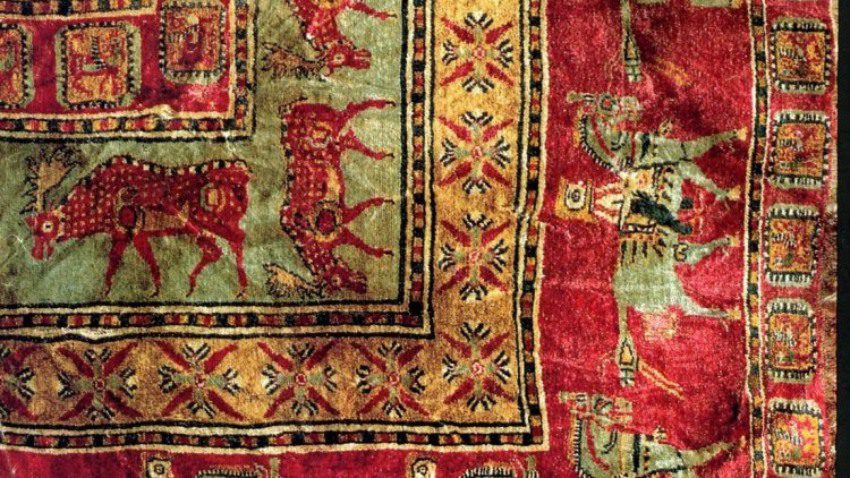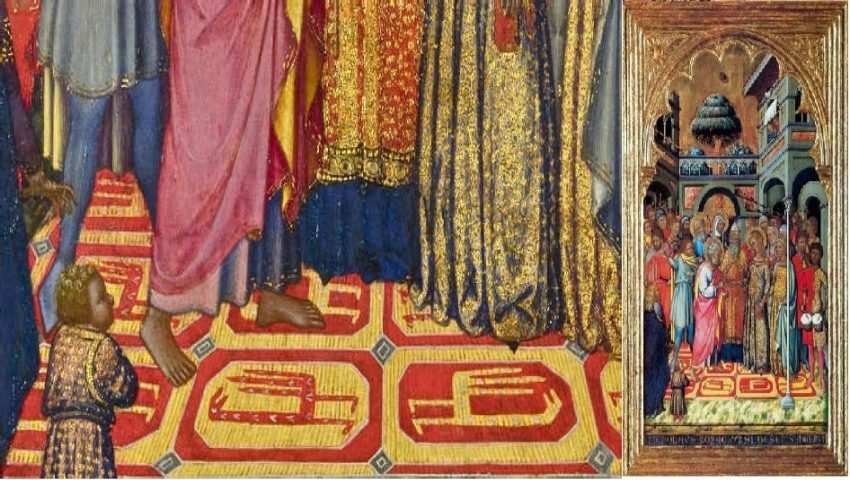Table of Contents
Traditional Turkish Carpet Art has an important role in our art history. The Turks were the first to bring the carpet to the Middle East and the Islamic world, demonstrating a significant advance in the area where Turkish people resided in Central Asia. The carpet originated in Central Asia because livestock husbandry is the Turks’ primary economic resource in their nomadic steppe civilization.
The Pazirik Carpet, discovered in the Central Asian Pazirik Kurgan, is the earliest known carpet. The carpet finest exemplifies both the style and skill of Central Asian art. The Pazirik carpet is very thinly woven, with 36 stitches per 1 cm square. The fact that the Pazirik carpet is constructed using the Turkish knot method (Gördes knot) demonstrates that Turkish carpet art has a long history. Furthermore, the Pazirik carpet has the first example of the octagonal Turkmen rose embroidery featured on Turkmen carpets.

About Traditional Turkish Carpet Art
Various animal combat scenarios and animal figurines on Central Asian Turkish carpets depict the society’s lives and beliefs at the period. The carpet predates the Central Asian Turks, however it is an appliqué carpet with no knot method. As a result, Pazirik Carpet is essential.
Turkish carpet art in Anatolia developed in a consistent and continuous manner from the 13th to the 19th centuries, with new carpet styles emerging at each stage.
The carpets of the Anatolian Seljuk era were the first key link in this development cycle. In terms of technique, color, pattern, and composition, Anatolian Seljuk carpets laid a firm basis. Technically, the Gördes knot was utilized in Seljuk carpets, and wool was selected as the material. Geometric shapes and stylised plant motifs are used to embellish the floor.
Furthermore, friezes resembling kufic calligraphy visible on the borders are among the essential features of this era carpets. The floor provides a vista that goes on forever with the same patterns. The notion of infinity, which is central to Turkish carpet art, can also be seen in Seljuk carpets. Light blue and light red on a dark blue or dark red backdrop are often utilized in carpets.
Seljuk era carpets include eight from the Konya Alaeddin Mosque, three from the Beyşehir Eşrefolu Mosque, and seven from Fustat. These carpets’ geometric and stylised floral themes, as well as enormous kufic inscriptions on the floor, are significant in traditional Turkish carpet art.
During the Principalities era, Aksaray, like the Seljuks, became a hub for the weaving of high-quality carpets.
With the appearance of animal-figured carpets in the 15th century, Turkish carpet art entered a new era.
This group, which is rich in animal images and compositions, was initially identified in the works of European artists.
The Ming carpet was the first original carpet discovered in the category of animal figured carpets. The carpet was discovered in a cathedral in central Italy, demonstrating how the animal-themed carpets manufactured in Anatolia spread.
Carpet in the Ottoman Empire
The Ottoman Empire continued the Seljuk tradition in carpet weaving. 15-16. Century Early Ottoman Period carpets are handled in four different groups. In the first and second groups of the early Ottoman period carpets (Holbein Carpets), the floor is divided into small squares, with octagons placed inside the squares and rhombus-shaped motifs arranged in shifted axes between them. These carpets, which are accepted to be woven around Uşak, were woven with wool material and Turkish knot technique.
In the third and fourth group examples, the floor is divided into two, three or four equal squares. Geometric motifs consisting of octagons are placed on each of the squares. These include eight-pointed star and plant patterns, stylized animals and fight scenes.

Ottoman palace carpets were woven by the Ehli Hiref organization. Carpets are made with materials such as silk wool and gold. Vivid and bright colors and rich motifs are dominant. This type of carpets, different from the classical understanding of Anatolia, seen in the second half of the 15th century, were called Ottoman palace carpets. These carpets changed style when Tabriz and Cairo joined the Ottoman Empire. It is woven inspired by Persian carpets. Iranian knot is used. With westernization, motifs such as baroque cartridges, rococo garlands, oyster shells, c and c folds, still lifes and landscapes were seen on the carpet.


